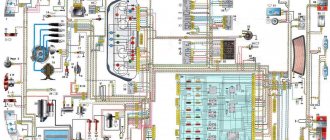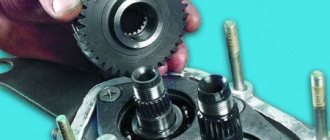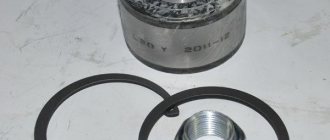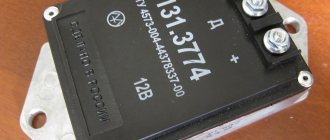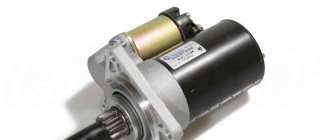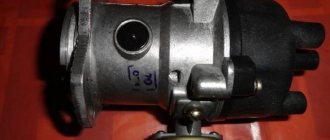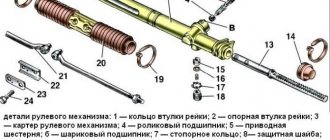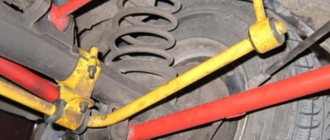Front-wheel drive VAZ cars are very popular in Russia due to their high maintainability, relatively low cost of spare parts, and simple design. But due to the large number of modifications, it is not easy for the driver to understand even the instructions where this or that unit (part) is located, in particular, on the VAZ-21099 car the injector.
Before repairing a car, some parts have to be searched for a long time and painstakingly, thus wasting a lot of time. In this article we will help you figure out where this or that device is located on the VAZ model 21099, and we hope that the information will be to some extent useful to car owners who have just bought a car, or to novice drivers.
Where is the fuel pump located on the VAZ-21099 injector
Removing and installing a gasoline pump (PG) is not a difficult job and does not require extensive plumbing experience or high qualifications. But if you don’t have to look for a fuel pump on carburetor cars for a long time (it is located on the engine, under the hood), then a beginner may not find it on the injector on the first try. Where is the fuel pump located on the VAZ-21099 sedan injector? Let's figure it out step by step:
- we move the front seats in the car forward as much as possible to free up space in the rear;
- open the rear left door of the car, find a small hinge on the rear sofa, which is located at the junction of the “seats” approximately in the middle of the cabin;
- pull the loop up, thereby raising the back of the lower seat;
- under the carpet we see the gas tank flap;
- unscrew the two fastening screws, remove the hatch and find the fuel pump underneath.
Tuning
This power unit allows you to increase power to 90-95 horsepower without loss of engine life. Engine tuning could be done by replacing the carburetor with a direct injection system, as well as by installing new lightweight flywheels and crankshafts. The VAZ 21099 engine with an injector produced about 90 horsepower.
There are also options for tuning the VAZ 21099 engine, which involve installing a turbine and supercharger on the power unit. It should be said that the installation of turbines made it possible to obtain a significant increase in power, but the service life of such an engine is significantly reduced. As a result, car owners had to carry out complex overhauls every 70-90 thousand kilometers.
Sources used:
- https://carnovato.ru/inzhektor-vaz-21099/
- https://avtodvigateli.com/marki/vaz-21099-inzhektor.html
- https://dvigatels.ru/russia/dvigatel-vaz-21099.html
Where is the fan relay VAZ-21099 injector
Quite often a problem arises with the Ninety-Nine when the engine fan does not turn on and the coolant begins to boil. If such a malfunction occurs, first of all they check the functionality of the fan itself by applying voltage directly to it from the battery, but there may be other problems.
In order to check the entire circuit, it is important to find where the VAZ-21099 injector fan relay is located, since it is responsible for turning on the airflow. We find this part in the front of the car, on the passenger side, it is installed under the glove compartment, at the passenger’s feet.
The required relay in the picture is indicated by an orange circle, and here you will also find a fuse that blows when the cooling fan is short-circuited.
Examination
Today, VAZ 2109 car owners use two methods to check the condition of the coolant temperature sensor. Let's say right away that the second one is more reliable, but the first one is easier. Decide for yourself which of the methods presented below to use.
Verification method
Your actions
According to the table, check whether the resistance corresponds to that required at a particular temperature of coolant or boiling water.
Temperature (in degrees Celsius)
Resistance (Ohm)
If there are deviations from the norm, we conclude that the sensor no longer performs its functions properly and therefore requires mandatory replacement.
Replacement
Where is the mass of the VAZ-21099 injector (main)
If the starter turns weakly, or the engine does not start at all (clicks occur when starting), various electrical problems arise, it is likely that the car does not have normal weight. Fixing such a problem is generally not difficult, but to do this you still need to know where the mass of the VAZ-21099 injector is located.
The main mass (thick) wire goes from the negative terminal of the battery to the engine, the thinner wire is connected to the car body, all energy consumers in the car depend on this connection. If the contact is poor, the battery stops charging normally; in order for the starter to turn well, you should check the reliability of these contacts and clean the metal from oxidation. If, due to a heavy load (for example, when installing additional equipment), the ground wire heats up and there is clearly not enough of it, you can “lay” additional ground almost anywhere where good contact between the engine and the body is ensured. The main thing is that this wire has a sufficient cross-section.
Trouble-shooting
Regardless of its own condition and the weather outside, the VAZ 21099 car may suddenly stop starting, practically not respond to the gas pedal, etc. In this case, the on-board computer behaves as usual and does not show any errors. Of course, you can continue to ignore the situation, but this is unlikely to lead to good things. It is imperative to look for a breakdown in the injector, because the road almost never forgives such carelessness. An unpredictable mechanism can stall at the most inopportune moment.
Most often, the breakdown affects injectors that become clogged from constant use.
As a result, the car may begin to consume several times more fuel, and its traction will decrease significantly.
It is quite possible to clean the injectors yourself, but only if the car owner is confident in his own abilities. Otherwise, you can make the situation even worse.
If problems arise, you should also pay attention to the throttle valve, which over time becomes overgrown with black soot. As a result, it begins to significantly inhibit the penetration of air, but this problem can easily be eliminated with the help of a cloth and a special spray.
In order for your car to operate flawlessly for many years, it is important to fulfill the following requirements:
The VAZ engine is quite durable and can withstand significant loads. However, there is a limit to its performance.
Where is the starter relay located?
Just like the engine cooling fan, the starter is controlled by a relay, and its malfunction can cause problems:
- when you turn the ignition key, nothing happens, the engine does not show any signs of life;
- When I try to start the engine, clicks are heard, but the starter does not crank.
Finding out where the starter relay is located on a VAZ-21099i car is very simple; to do this, you just need to open the hood of the car and look behind the air pipe of the injection engine; the part you are looking for is shown below in the picture.
Installation of gas equipment
HBO by car
Installation of LPG on a VAZ is possible due to the presence of injectors. Some people install gas equipment without thinking about whether it is really necessary. In fact, HBO is a wonderful addition for VAZ, but it also has its drawbacks.
Installing an LPG does not make sense if the driver does not travel very far, because the main advantage of this equipment is savings when traveling long distances. For example, if a car travels 100 km a day, then installing LPG will reduce fuel costs by almost 2 times, but if the mileage is 20 km a day, then there will not be much savings.
The main disadvantages of HBO for the car and its owner are the following:
- loss of dynamics;
- decent cost of equipment installation;
- complication of the fuel supply system (as a result - more breakdowns);
- weighting the car.
However, it is necessary to note some advantages of HBO.
- Reducing the likelihood of detonation. No matter how strange it may sound, it is true. Gasoline is more likely to ignite than gas.
- Less harmful emissions.
If after installing the LPG the car jerks strongly, contact a specialist immediately! This behavior of the car can be a sign of many serious problems.
Where is the temperature sensor located?
If the temperature sensor does not show on the instrument panel, there is a high risk of overheating the engine, since the instrument panel does not inform the driver about the heating of the internal combustion engine coolant. Of course, the instrument panel or electrical wiring may be faulty, but most often the temperature sensor (DTOZH) on the engine itself refuses to work.
Where is the temperature sensor located on an injection car 099? Of course, you need to look for it in the engine compartment:
- open the hood;
- we find the wiring that is located between the rear of the engine valve cover and the air filter housing;
- where the DTOZH is located can be seen in more detail in the following photos.
Content
The injector is controlled by electrical signals that come from a microprocessor
, and in order to issue them, he monitors signals from sensors installed on and in the engine.
The only work that can be done on an injection engine to adjust it and stabilize its operation is flushing the injector, or rather flushing the injectors.
Where is the speed sensor located?
The speed sensor (DS) on front-wheel drive VAZ cars reads pulses depending on wheel speed and transmits the data to the electronic control unit (ECU). When braking the engine, the fuel supply is turned off with the help of the diesel engine and the computer, thus achieving more economical operation of the internal combustion engine. If the sensor is faulty, an error code is recorded, gasoline consumption increases slightly, and idle speed decreases, especially during heavy braking. It is difficult to immediately detect where the speed sensor is located, since it is hidden under the air filter housing (AFC).
We find the part we need as follows:
- open the hood of the car;
- Using a 10mm wrench, unscrew the two KVF fastening bolts;
- loosen the clamp of the air “corrugation”, disconnect the “chip” with the wires;
- we take out the KVF, now the sensor has already appeared in the field of view, it is located on the gearbox (gearbox) housing, wires are connected to it, connected using a connector.
The DS can be easily unscrewed by hand, and the plug with wires can be pulled out even after the sensor has been unscrewed (but carefully so as not to damage the wiring during rotation).
Repair
Repair of the power unit is carried out with your own hands. As practice shows, most car enthusiasts carry out this process in their garage. Elements such as the thermostat, water pump, spark plugs and high-voltage wires can be changed without problems. As for the injectors, to clean them you will need a special stand, which is available at car services.
To reduce fuel consumption, you can flash the engine control unit. This is what motorists do. This operation can only be performed independently, but it is recommended to contact professionals who understand the process and also carry out additional adjustments.
Carrying out a major overhaul will require some design knowledge and engine repair skills. So, to grind the plane of the block and head, you will need a surface grinding machine. Also, for boring cylinders, a boring and honing stand is required. All other operations are performed by hand.
Where is the fuel filter located?
The fuel filter (TF) on the VAZ-21099i is designed to clean gasoline from debris, dirt and various impurities; it is a monolithic structure with a rigid metal body and a filter element inside. The frequency of its replacement is every 20-30 thousand km of the distance traveled, also if the car begins to move jerkily, and diagnostics showed that the fuel pump is clogged.
It’s easy to find out where the fuel filter is located; to do this, you need to install the car on an inspection hole or a car lift. The TF is located on the bottom of the body, next to the rear beam and the gas tank, and is secured with a special clamp, which is tightened with a bolt and nut.
Before you start changing the filter, you need to relieve the fuel pressure, otherwise when you unscrew the fuel fittings, gasoline will splash under high pressure. You can relieve pressure in the line using a special nipple located at the rear of the fuel rail. Before starting such an operation, it is necessary to prepare a plastic container into which gasoline should be poured, then unscrew the safety cap.
To release the pressure, you can use a standard flat-head screwdriver; when you press the nipple valve, gasoline will come out of the system.
After removing fuel from the line, we proceed to replacing the fuel pump.
Related articles:
- Possible ways to increase engine power with your own hands Tuning a car engine is a popular topic on many forums; car owners are often dissatisfied with the dynamics of their car; they often want better technical characteristics of the internal combustion engine in small and […]
- Anti-gravel treatment of the underbody of a car - stages, materials used The most important enemy of a car body is corrosion; rust primarily appears in areas of the body with unprotected metal, not covered with paint, primer, special […]
- Flushing the engine cooling radiator from the inside and outside Flushing the engine cooling radiator should be done periodically, and you should not wait for the engine to start constantly warming up - overheating leads to engine failure, and all this […]
Specifications
The VAZ 21099 engine has the following technical characteristics:
Download .xls file
xls
Download picture
Send by email
| OPTIONS | VALUES |
| Years of manufacture | 1990 - 2011 |
| Weight | N. d |
| Cylinder block material | cast iron |
| Motor power system | carburetor |
| Type of cylinder arrangement | In a row |
| Engine displacement | 1.5 liters |
| Engine power | 73 l. With. |
| Number of cylinders | Four |
| Number of valves | Two |
| Piston stroke | 71 millimeters |
| Cylinder diameter | 82 millimeters |
| Compression ratio | 9.8 |
| Torque Nm/rpm | 106 /360 |
| Environmental standards | EURO 2 |
| Fuel | petrol |
| Fuel consumption | 7.8/100 km |
| Oil | 5W-30 |
| Oil volume in crankcase | 3.5 liters |
| When replacing, pour | 3.2 liters |
| Oil change is carried out | every 15 thousand km |
| Motor life | |
| - according to the plant | 125 |
| - on practice | 250 |
The following models are equipped with this motor: 21083, 21093, 21099, 21111, 2115.
Engine crank mechanism
The design of the cylinder block of the VAZ-2111 engine is identical to block 21083. It is cast from cast iron, the cylinder diameter is 82 mm, and if the piston group is replaced, it can be increased by:
- 0.4 for the first repair;
0.8 at the second.
Crankshaft
The crankshaft is located at the bottom of the block and rotates on five main bearings that have removable covers, which are secured to the block with bolts. The covers are not interchangeable and are marked with marks on the outside. The middle support of the main bearing has slots into which support half-rings are installed, eliminating axial displacement of the crankshaft. The front half-ring is made of an alloy of steel and aluminum, the rear half-ring is made of cermet. If play in the crankshaft appears, the half rings must be replaced.
The bearing shells - support and connecting rod - are thin-walled, made of steel-aluminum alloy. There are grooves on the inside of all the upper main bearings, with the exception of the third bearing bearing.
The design of the crank (engine crankshaft) is as follows: it is cast iron, has four connecting rods and five main journals. Eight counterweights are cast together with the shaft. Channels are drilled inside the shaft, closed with plugs and having a dual purpose:
- they supply oil to the connecting rod journals from the main ones;
- they clean the oil, since centrifugal force throws all mechanical impurities that are not retained by the filter towards the plugs.
Article on the topic: Do-it-yourself repair of the VAZ 2110-2112 fuse box
The latter circumstance must be taken into account when overhauling the engine, and when removing the crankshaft, and especially when balancing, it is necessary to clean the channels from accumulated deposits. After cleaning, the plugs are replaced with new ones.
The camshaft drive pulley is attached to the front part of the crankshaft, and to it is the generator drive pulley, which also works as a damping device, thanks to the elastic element between the outer and inner parts of the pulley. A cast iron flywheel is attached to the rear end using six bolts. It has a ring gear designed to start the engine using a starter. In addition, there is a conical mark on its surface, designed to determine TDC after the engine is assembled.
Piston group
The connecting rods are made of steel and have an I-section. The covers are processed together with the connecting rods, and therefore are not interchangeable. The cylinder number is stamped on them and on the connecting rods.
Piston pins are steel tubes. They float freely in the piston bosses, in which they are fixed using retaining rings.
Piston design: the pistons are made of aluminum alloy and have three grooves in the upper part for piston rings. The set of rings for each piston consists of two compression rings and one oil scraper ring. Compression rings prevent gases from entering the crankcase, and the oil scraper removes oil from the cylinder walls and carries it to the bosses to lubricate the piston pin.
Slightly lower are the holes for the piston pin (boss). There is a recess in the bottom of the piston designed to prevent bending of the valves in the event of a break in the timing belt. In the VAZ-2109 with an engine capacity of 1.3 liters, it is flat, so a broken belt inevitably led to failure of the entire piston group and gas distribution mechanism, and as a result, to expensive repairs.
Block head and timing device
All front-wheel drive cars of the VAZ family, be it 2109, 2110 or 2114, have one cylinder head, common to all cylinders. They are mounted to the block using ten screws. During installation, a metal gasket is placed under it. This gasket is for single use and cannot be reused. There are five camshaft bearings at the top of the cylinder head.
Article on the topic: Oil leakage from under the valve cover: why does it occur and what to do?
The camshaft of the engine of the VAZ-2109 car has the index 21083. Some engines are equipped with 2110 or 2111 shafts; their design is slightly different from 21083, which allows for an increase in engine power. The shaft is cast from cast iron, there are five supports and eight cams on it that open the valves. It is driven by a toothed belt from the crankshaft pulley. The shafts can be correctly installed relative to each other using the alignment lug on the rear timing belt cover and the marks on the drive gears and flywheel.
Seats are pressed into the cylinder head, as well as valve guides. On the inside of the bushings there are grooves for supplying lubricant; the bushings are closed on top with oil deflector caps.
The valves are made of steel, and the intake head is made of heat-resistant steel. They are mounted obliquely in one row. The inlet valve has a larger diameter than the outlet valve. The gaps between the valves and camshaft cams are adjusted using shims that have increased wear resistance.
Pushers are metal cups moving in the cylinder head holes. To improve wear resistance, the surface in contact with the ends of the valve stems is cemented.
Wiring diagram for VAZ-2109 carburetor
- Headlight.
- Electric motor for headlight glass cleaning system. An optional part, used mainly on export vehicles.
- Limit switch for powering the engine compartment lamp.
- Klaxon.
- An electric motor drives a fan installed on the radiator of the cooling system.
- Temperature indicator that provides a control signal for the electric drive of the fan impeller.
- Alternator.
- Fluid supply valve for headlight glasses. Used in conjunction with paragraph 2.
- Fluid supply valve for the glass of the fifth door.
- Fluid supply valve to the front glass.
- Spark plugs.
- Hall sensor used to distribute ignition pulses.
- Coil.
- Limit switch for reverse gear lights.
- Fluid temperature meter in the cooling system.
- Starter.
- Accumulator battery.
- A sensor that measures the fluid level in the brake booster.
- Switch that controls the ignition system.
- Sensor for determining the position of the top dead center of the piston of the first cylinder. Installed on some export VAZ 2109 with a diagnostic system. Found only on cars before 1995.
- Diagnostic block. Optional element, installed together with item 20.
- Controller for controlling the solenoid valve installed in the carburetor.
- Starter switch contact block.
- Limit switch on the carburetor.
- Economizer valve.
- Sensor signaling an emergency decrease in oil pressure.
- Washer pump drive.
- Fan impeller motor for ventilation and heating systems.
- Resistance providing additional fan speeds.
- Speed shifter.
- Windshield wiper drive.
- Cigarette lighter.
- Illumination system for levers for adjusting heater operating parameters.
- Socket for additional equipment.
- Lamp for auxiliary lighting of the engine compartment.
- Illumination system for the glove box on the instrument panel.
- Relay and fuse link mounting block.
- Instrument panel light switch.
- Parking brake lamp limit switch.
- Brake lamp limit switch.
- Steering column switch lever block.
- Exterior lamp switch.
- Hazard switch.
- Turn on the rear fog lamp.
- Bimetallic fog lamp fuse.
- Heated glass switch on the fifth door.
- Turn signal repeaters on the front fenders.
- Central interior lighting.
- Individual lampshade.
- Switches for backlight operation on the middle pillars.
- Ignition switching unit.
- Egnition lock.
- “Low” type instrument cluster.
- Choke limit switch on the carburetor.
- Rear lights.
- Fuel level meter in the tank.
- Heated glass.
- Rear wiper drive.
- Two lamps for room illumination.
Are your brakes squeaking?
It’s not scary: it’s just time to change the front brake pads. Replace the brake discs too. This procedure will not cost much. If the summer season has begun, then do not wait until potholes, hummocks and other attributes of the post-Soviet space completely ruin your car; replace the front struts with German Bilshtain ones. Look at the photo to see how they look.
